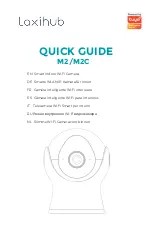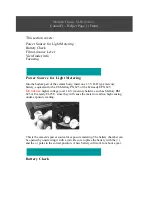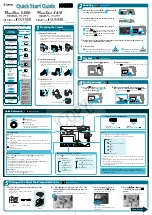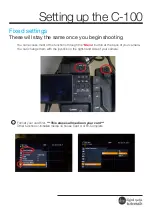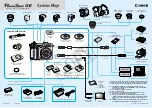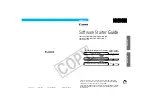
C & C ASSOCIATES
troubleshooting
ELECTRONIC TROUBLESHOOTING THE OLYMPUS OM-4
1. CIRCUIT DESCRIPTION
Power Circuit
As with other OM-series cameras, battery positive
connects to the chassis and to the flex circuit through
screws holding the circuit in place. In this guide, battery
positive is designated as Vcc and connections to the
chassis are shown as the "earth" symbol,
A black wire connects battery negative to the Shutter
Terminal Board and to the main flex near the rows of
variable resistors, From there, conductors fan out to pins
22, 51, IC-101; pins 6, 26, 62, IC-102; and pin 13, IC-103.
The Display Flex and Reset Board receive battery
negative through a black wire soldered to the Main Flex
near IC-101,
When batteries are installed, a quartz oscillator
involving two capacitors and IC-101 is activated.
Pressing the release button one-half stroke closes switch
SW-I11 to connect pins 15 and 18, IC-101. IC-101 then
signals IC-102 to power up the metering circuit and the
LCD for about 2 minutes. Power signals are from pins 53,
54, IC-101 to pins 24, 23, IC-102. Pressing the release
button renews the 2-minute power latch, A 1.8v constant
voltage, Vref
s
is generated at pin 75, IC-102.
A diode is connected to the battery terminals in reverse
direction to protect the circuit if batteries are installed
backward.
Battery requirement: two S-76 silver oxide or two
LR44 alkaline-manganese.
Metering Circuit
There are four ICs involved in metering, exposure
control, and display. IC-101 contains a microprocessor
(CPU) and understands only binary signals as inputs and
outputs. It keeps track of mode, calculates exposures,
and owns the clock. IC-102 is a bipolar IC which contains
comparators for A / D conversion, watches over variable
resistors, c o n t r o l s m a g n e t s a n d LEDs, a n d
communicates with IC-101,
IC-103, under the floor panel of the mirror box,
supports "average" and "spot" photodiodes with
amplifiers and temperature compensation circuits. It also
takes care of integration for automatic exposure in
ambient and flash modes. IC-104 is a decoder/driver for
the comprehensive LCD.
Prior to exposure a sub-mirror behind the reflex
mirror reflects a portion of light going to the viewfinder
to the photodiodes on IC-103, A BV voltage, changing
18mv/Ev with light, is output from pin 16, IC-103 to pin
7, IC-102, At the same time, IC-102 watches aperture
setting (AV-VR at pin 74), ASA (SV-VR at pin 67), and
shutter speed setting (TV-VR at pin 73). Although
variable resistors are used
s
they are part of an analog-to-
digital conversion process which changes all exposure
information to binary codes for the CPU.
The code is sent back as series data from pin 38, IC-102
to pin 29, IC-101 so the CPU knows ASA, aperture
setting, and shutter speed setting. How the CPU
interprets the data depends upon operating mode
selected, IC-101 will calculate an exposure, then send a
coded message to IC-104 which drives an LCD display to
indicate exposure and other information, A quartz clock
operating at 32.8 KHz keeps the operation orderly and
the whole process is repeated every 100ms to keep data up
to date,
IC-101 sends digital-to-analog data along eight lines
(DAC-0 to DAC-7). During exposure in Manual and
Spot modes, IC-103 will need analog voltage to set
exposure times.
Details such as different voltage levels between average
and spot SPDs are taken care of by voltage boosting
circuits. Because of a wide exposure range, integration
capacitors are switched in and out of circuit according to
ASA setting,
Release Circuit
Pressing the release button full stroke mechanically
unlatches the mirror as with other OM-series cameras, As
the mirror rises, switch SW-101 closes to connect Vcc
(B+) through two diodes to bases of transistors Q-103 and
Q-904. As the transistors turn on, pin 49, IC-101 is set low
and pin 58, IC-102 is set high. In this manner the ICs are
told the mirror is on its way up and they had better gel
ready for an exposure. IC-101 stores exposure data and
LEDs are temporarily disabled to conserve power.
IC-101 also sets an exposure program according to mode.
IC-102 tests battery voltage to be sure it is above 2.65v,
then pin 61 goes low. Pin 61 is connected to the base of
transistor Q-201 (PNP) on the shutter board, Q-201
switches on causing capacitor C-201 to discharge through
the coil of combination magnet M-l. M-l repels its
keeper which unlatches the opening curtain, IC-102 then
waits for switch SW-103, the Trigger Switch (Timing
Switch), to signal the first curtain is moving before
initiating exposure control.
Summary of Contents for OM-4
Page 22: ...OLYMPUS OM 4 PAGE 22...



















